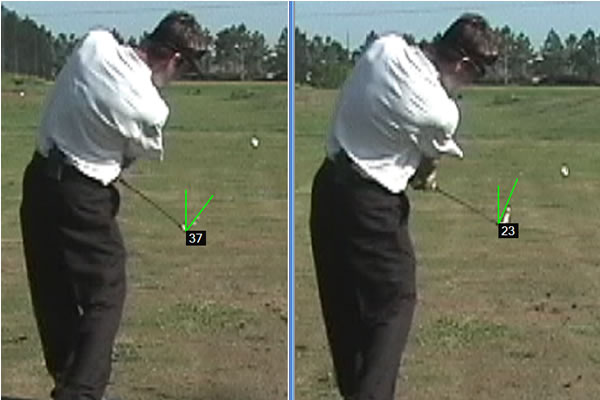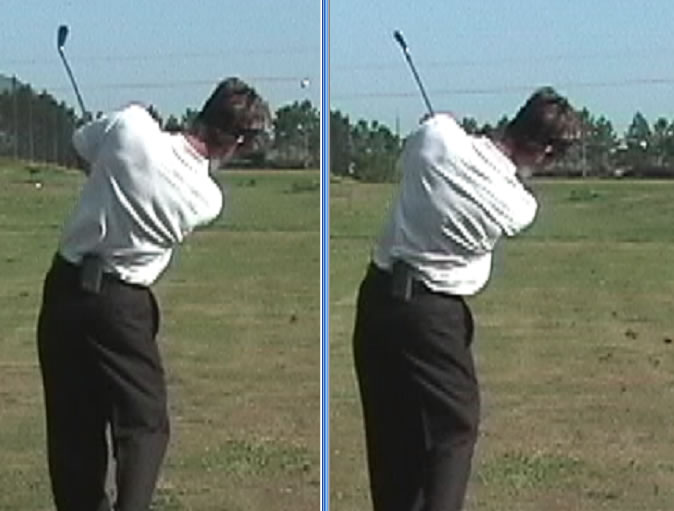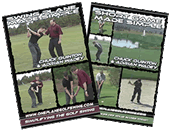Full Swing
Rotary Swing Tour - Anatomical Absolutes of Golf
Rotary Golf Learning Series
Golf Biomechanics Home Page
1. RST Overview
2. Use of the Hips and Core - Driver Swing
3. Biomechanically Correct Golf Setup and Balance
4. Functional Squat and One Legged Exercises
5. Functional Bridge Exercises
6. Inner Thigh/Hip Exercise
7. Back Stabilizer Exercise
8. Push vs. Pull
9. Golf Core Rotation Exercises
10. Golf Swing Weight Shift - Part 1
11. Golf Swing Weight Shift - To the Right - Part 2
12. Golf Swing Weight Shift - To the Left - Part 3
13. Sean O'Hair - Rotary Swing Tour
14. Common Swing Faults Caused by Setup
15. The Takeaway in the Golf Swing
16. Understanding Shoulder Elevation
17. The Role of the Right Arm in the Takeaway
18. Posture's Affect on the Takeaway
19. Golf Instruction - Muscle Activation
20. Tiger Woods Biomechanics
21. Move 2 - Completing the Backswing
22. Move 3 - The Golf Downswing
23. Creating a Golf Swing Plane
24. Effects of Bad Ball Position
25. 9 to 3 Drill
26. Move 4 - The Follow Through
27. Common Faults in the Follow Through
28. Tiger Woods - Getting Stuck - Downswing
29. Throw the Ball Drill
30. Right Arm Only - Downswing Drill
Rotary Swing Fundamentals
1. Golf Swing Fundamentals Home
2. Athletic Address Position
3. Body Movement
4. The Arms in the Golf Swing
5. Golf Spine Angle
6. Golfswing Takeaway
7. Proper Golf Grip
8. Golf Swing Rhythm Drill
9. Starting the Swing
10. Proper Divot
11.Forearm/Shaft Alignment
12. Head Behind the Ball
13. Golf Swing Wrist Hinge & Cock
14. Hip Turn
15. Hip Rotation Through Impact
16. Takeaway Chin Line
17. Passive Arms in the Golf Swing
18. Biomechanically Shorten Backswing
19. Rotation vs. Tilting Shoulders
20. Golf Swing Transition Bump
Rotary Golf Swing Drills
1. Golf Swing Drills Home
2. Body Drill
3. Impact Bag
4. Divots Left Tee Drill
5. Golf Baseball Swings
6. Broom Drill
7. One Leg Drill
8. Headcover Drill
9. Foam Roller Drill
10. Ben Hogan Pane of Glass
11. Shaft Plane Drill
12. Slide the Shaft Drill
13. 9 o'clock Swing Plane
14. Rotary Drill
15. Penetrating Flight Drill
16. In to Out Tee Drill
17. Neck Tie Drill
18. Bucket Drill for Synchronization
19. Lag Drill - Improve Your Golf Swing
Faults and Fixes
1. Faults & Fixes Home
2. Understanding Your Misses
3. Fixing a Hook
4. Fixing a Slice
5. Hitting Fat
6. Hitting Thin
7. Shots off the Toe
8. Shots off the Heel - Shanking
9. Left Side Breakdown
10. Pulled Shots - Student Analysis
11. Slicing
12. Coming Too Far From the Inside
Advanced Technique
1. Advanced Technique Home
2. Impact vs Address
3. Fade vs Draw
4. Hitting a Draw
5. Hitting a Fade
6. Hit It Low
7. Hit It High
8. Tiger Woods 2 Iron Stinger
9. Driver off the Deck
10. The Three Releases
11. Pinky Grip
12. Arms vs Body Release
Rotary Hitter
1. Rotary Hitter Intro
2. Impact Position
3. Chip Stroke
4. Hitter Backswing
5. Shoulder Turn and Right Arm Throwing Motion
6. Hitter Takeaway
7. Hitter vs Swinger
8. Right Hand Pressure Point w/ the Pure Ball Striker
Two Plane
Golf Impact Video Series
Short Game
1. Swinging Over the Top
2. Flat Left Wrist
3. Driver vs. Irons at Impact
4. Impact Fix Drill
5. Importance of Proper Grip
Bomb Your Driver Series
1. Bomb Your Driver Home Page
2. Ball Speed
3. Clubface Roll
4. Driver Sweetspot
5. Optimum Ball Launch Angle
6. Driver Golf Ball Spin Rate
7. Increase Clubhead Speed with More Lag!
8. Tiger Woods Most Inefficient Driver on PGA Tour
9. Driver Head Center of Gravity Design
Performance Putting Series
Putting
Mental Game
1. Forearm Shaft Alignment
2. Putting Distance Control
3. Putting Shaft Drill
4. Putting Acceleration Drill
5. Putting Hand Dominance
6. Face Angle in the Putting Stroke
7. Pendulum Putting Stroke
8. Putting Fitting - Shaft Length and Setup
Wedge Play
Mushin Golf
Golf Instruction
1. Mental Game Home
2. Introduction
3. Taking it to the Course
4. 10 Mental Principals
5. Confidence
6. You Are An Athlete
7. Spring Golf
8. Ultimate Destroyer
9. How To Practice
10. Developing a Mental Putting Routine
Course Management
1. Rotary Swing Golf Academy
2. In Person w/ Chuck Quinton
3. Driver Fittings
4. Demo Matrix Shafts and Nakashima Heads
5. Online Golf Lessons
6. Flightscope Kudu Launch Monitor at RSGA
Golf Equipment
1. Properly Fit Shafts
2. 2006 Golf Ball Review
3. Using a Launch Monitor
4. Sandwedge Bounce Angle
5. Flightscope Kudu Launch Monitor at RSGA
6. Demo a Matrix Driver Shaft!
7. Eyeline Golf Putting Plane
Professional Swings
Pro Golf Swing Sequences Home
Ben Hogan
Member's Swings
Golf Fitness
1. Ben Hogan's Swing
2. Ben Hogan's Shoulder Plane
3. Ben Hogan's Swing Face On
4. Ben Hogan's Swing Down the Line5. Ben Hogan - Reverse Pivot?
6. Ben Hogan's Address Position
Tiger Woods
1. Tiger Woods Swing Dynamics
2. Tiger Woods New Swing with Hank Haney
3. Tiger Woods Address
4. Tiger Woods Takeaway
5. Tiger Woods Backswing
6. Tiger Woods Downswing & Impact
7. Tiger Woods Most Inefficient Driver on PGA Tour
Chuck Quinton
1. Quinton 6 Iron Down the Line
2. 6 Iron Face On
3. Driver Face On
4. Driver Down the Line
5. Chuck Quinton DTL Analysis
6. Quinton Face On Swing Analysis
7. TaylorMade Performance Lab
Paul Dickinson
Stuart Appleby
Ernie Els Golf Swing DTL
Ernie Els Grip
Jose Maria Olazabal
Annika Sorenstam
Peter Jacobsen
Sam Snead
Adrian Wadey Face On
Adrian Wadey Down the Line
Tyler Aldridge 2007 PGA Tour Qualifying School
1. Golf Fitness Exercises
2. Hitting with Your Core
3. Balance on Swiss Ball
4. Golf Fitness Bridge Exercise
5. Stretching the Core
6. Advanced Leg Exercises
7. Intermediate Let Exercises
8. Losing Spine Angle in Golf Swing
Membership Info
Golf Tips & Info
1. One Plane vs. Two Plane Swing
2. One Plane Swing in Depth
3. Model Golf vs. One Plane
4. My Swing Philosophy
5. List of One Plane/Rotary Swing Instructors
6. Golf Chat Live Transcript
7. Golf Blog
8. Analyzing Golf Ball Flight
9. Stop Casting the Club
10. Causes of a Slice
11. Core Performance Golf
12. Efficiency of Movement
13. Fred Couples Golf Swing
14. Releasing the Golf Club
15. Hank Haney's Swing with Tiger Woods
16. Iron Shaft Survey
17. Key Components to Hardy's Swing
18. Losing Spine Angle
19. Mixing One and Two Plane Swing Fundamentals
20. Mushin Golf
21. Passive vs. Active Arms
22. Problem with Jim Hardy's Swing
23. Secret of Clubhead Lag
24. Right Arm in Golf Swing
25. Stuart Appleby's Golf Swing Video
26. Clubface Angle Video
27. Tiger Woods New Swing
by Chuck Quinton
Differences in Swing Mechanics while Working Hitting a Fade and Draw |
Rotary Swing Golf |
![]() Watch "How to Hit a Draw" Video
Watch "How to Hit a Draw" Video
![]() Macromedia Flash Player Required (Free
Download)
Macromedia Flash Player Required (Free
Download)
For most amateur golfers, hitting a controlled draw is their ultimate
goal. This is usually because they tend to slice and miss everything to the
right, so a nice controlled draw seems desirable. While it is an easy to shot
to learn how to hit using the one plane swing, it shouldn't be any golfer's
life long goal to learn how to play a draw. If you hit a fade and can control
it consistently, don't think you need to learn how to hit a draw to become
a better golfer, it's simply not true. A draw is the most difficult shot to
control overall because you are playing with the timing of the release of
the club, and playing with timing is like playing with fire, you're bound
to get burned some time. It's true, you can keep the clubface shut throughout
the swing and close your stance and learn to hit a draw that way, but you
will struggle a great deal just to hit the ball straight consistently and
will have a very difficult time fading the ball. The best way to play golf
is to go with whatever your natural ball flight is and try an make it as neutral
as possible. If you tend to hit a draw already, try to keep it under 5 yards
of right to left movement in general. The more it is moving right to left
(for righties) the more you are releasing the club or keeping it shut and
closing your stance and the more difficult it will be to hit the ball straight
or fade it. If you can keep your swing fairly neutral, working the ball in
either direction becomes a very simple matter and very few modifications are
necessary in order to work the ball.
Observe the picture below. In the picture on the left I am hitting a 3 yard fade and the picture on the right I'm hitting a 3 yard draw. Note that my swing has remained exactly the same, nothing changed other than the angle of my clubface. I've clearly held on to the release in the picture on the left and this has not only imparted a cut spin on the ball but launched it on a higher trajectory as well when compared to the shot where I hit a draw.

As I come into the finish, you can clearly see the angle in the clubface is significantly different. The one on the left is much more open as I have worked to keep the clubface open through the shot and the one on the right is more square or slightly closed. You can also see again the difference in trajectory here, the ball on the right is still significantly lower than that the one on the right. When comparing these two swings (as I've done in this swing comparison ), you can see that very few changes are necessary for me to work the ball in either direction and that gives me the most flexibility in my overall shotmaking ability.

|
|
|
| ||||||||



